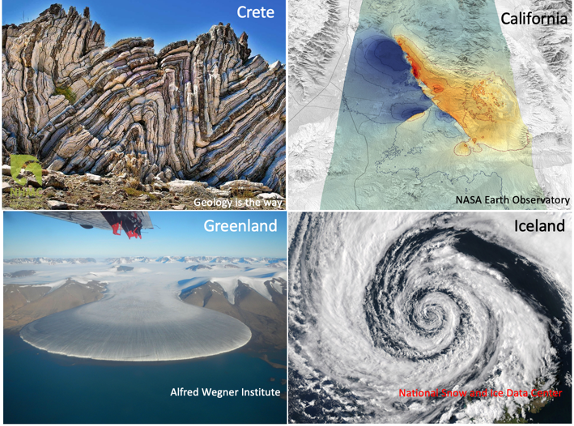GEO 325C/398C Continuum Mechanics
Jackson School of Geosciences - University of Texas at Austin
Project maintained by mhesse Hosted on GitHub Pages — Theme by mattgraham
Course Description

Continuum Mechanics is a new upper division undergraduate/beginning graduate course focused on developing the foundations of solid and fluid mechanics and thermodynamics of continua, and their application to geophysical and geological models such as mantle convection, ice sheet flow, and geophysical fluid dynamics. The emphasis is on a rigorous quantitative three-dimensional description, beginning with tensor analysis, forces, and stresses, and kinematics, motion, and strain; moving to the basic balance (i.e. conservation) laws of mass, momentum, and energy as well as constitutive relations for fluid and solid media; and ending with the application of these laws and relations to the governing equations of oceanography, seismology, glaciology, and geodynamics.
Previous versions of this course: Fall 2021, Fall 2022, Fall 2023, Fall 2024
Class room
- Class Time: TTH 9:30 am-11:00 am
- Class Room: EPS 1.126
- Class unique: 28965/29340
Office hours
- [Office hours poll]
- Time: MW 9-10am
- Location: JGB 4.216B (Geophysics Dojo)
Additional course websites:
- Piazza - Discussion board
Relevant textbooks
We will most closely follow:
- A first course in continuum mechanics, by Gonzalez and Stewart
- Continuum Mechanics in the Earth Sciences, by Newman
Other useful books are:
- Rheology of the Earth, by Ranalli
- Physics of continous matter, by Lautrup
- Introduction to continuum mechanics, by Gurtin
- Nonlinear solid mechanics, by Holzapfel
Topic I: Review
Lecture 1 (Aug 26): Vector review and index notation
- Topics: Introduction to the class, review of vectors, index notation
- Slides: Introduction to course
- Notes: Vectors and Index Notation
Lecture 2 (Aug 28): Linear momentum and force
Topics: Newton’s laws, Body and surface forces, Hydrostatic equilibrium, Isostacy
- Notes: Force Notes, Isostacy
Lecture 3 (Sep 2): Angular momentum and torque
Topics: Angular momentum, torque, moment, tipping
- Lecture: Part 1 [pdf] [rec], Part 2 [pdf] [rec]
- Notes: Triple vector product, Torque, Toppling Icebergs, Stability
- Movie: Ice bergs toppling over
Topic II: Tensors and Stress
Lecture 4 (Sep 4): Tensor algebra
Topics: Tensor representation and basis, dyadic product, trace, transpose.
- Lecture: [pdf], [rec]
- Notes: Tensor Intro
Lecture 5 (Sep 9): Cauchy stress tensor
Topics: Traction, Action & Reaction, Cauchy’s principle
- Notes: Cauchy stress tensor
Lecture 6 (Sep 11): Rotations
Topics: Orthogonal tensors, Euler representation, Fault normals
- Notes: Rotations, Fault normals
Lecture 7 (Sep 16): Prinipal stresses
Topics: Normal and shear stress, principal stresses
Lecture 8 (Sep 18): Change in basis and spectral decomposition
Topics: Change in basis tensor, eigen problem
- Lecture: pdf rec
- Notes: Change of basis, Nankai Fault Stress Example [script] [pdf]
Lecture 9 (Sep 23): Mohr circle
Topics: Mohr circle, maximum shear stress, failure
- Notes: Mohr circle,
Lecture 10 (Sep 25): Divergence and gradient
Topics: Gradient, divergence, Laplacian, Poisson’s equation for gravity
- Notes: Div and Grad
Lecture 11 (Sep 30): Integral theorems
Topics: Curl, Divergence and Stokes theorems, Derivatives of tensor functions
- Notes: Curl, Gauss, Stokes
Lecture 12 (Oct 2): Equilibrium Equations
Topics: Equilibrum equations, symmetry of stress tensor, hydrostatic shapes, Figure of the Earth
Midterm Exam (Oct 7):
Topic III: Kinematics and Strain
Lecture 13 (Oct 9): Deformation Map and Gradient
Topics: Deformation map and gradient; change of material lines, volumes and areas
- Notes: Deformation Map and Gradient
Lecture 14 (Oct 14): Cauchy-Green Strain Tensor
Lecture 15 (Oct 16): Interpretation of the Strain Tensor
- Notes: Cauchy strain relations
Lecture 16 (Oct 21): Infinitesimal Strain Tensor
Lecture 17 (Oct 23): Motion and Material Derivative
Lecture 18 (Oct 28): Rates of deformation & Reynolds Transport Theorem
- Notes: Rates, Reynolds Transport Theorem
Topic IV: Balance Laws and Constitutive Theory
Lecture 19 (Oct 30): Eulerian balance laws
- Notes: Balance laws
Lecture 20 (Nov 4): Energy balance - heating
Lecture 21 (Nov 6): Energy balance - working
Lecture 22 (Nov 11): Constitutive laws
Topic V: Applications
Lecture 23 (Nov 13): Navier Stokes
- Notes: Navier-Stokes
Lecture 24 (Nov 18): Boundary layers
Lecture 25 (Nov 20): Creeping flow
- Notes: Kinetic energy, Stokes equation, Power-law creep